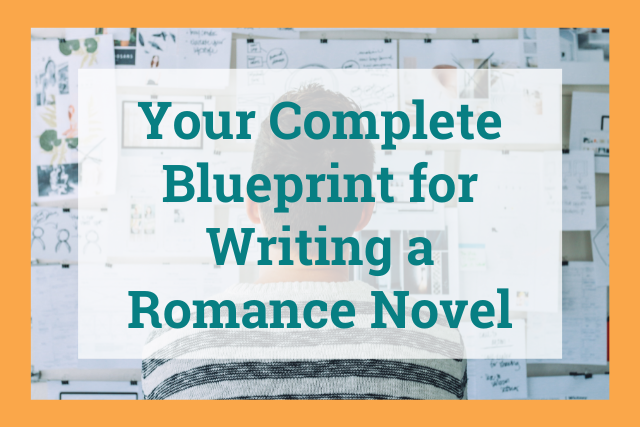
Your Complete Blueprint for Writing a Romance Novel
So you’ve got an idea for a romance novel. You’ve come up with the core premise, identified your main characters, and maybe even envisioned some of the key scenes that you know readers are going to love.
Now you need to turn this jumble of ideas into an actual book.
How do you put it all together?
If you’re a plotter, like me, you’re probably excited to build a plot outline for your novel so you can plan out the story. But even if you aren’t a plotter and prefer to make things up as you go, story structure is still important to understand.
The romance genre has many conventions and tropes. Your readers will expect certain things from your novel at different parts of the story—tension, drama, heartbreak, and more.
By starting with the right plot outline, you set yourself up to fulfill those expectations and craft a satisfying romance novel that both new and experienced readers will love.
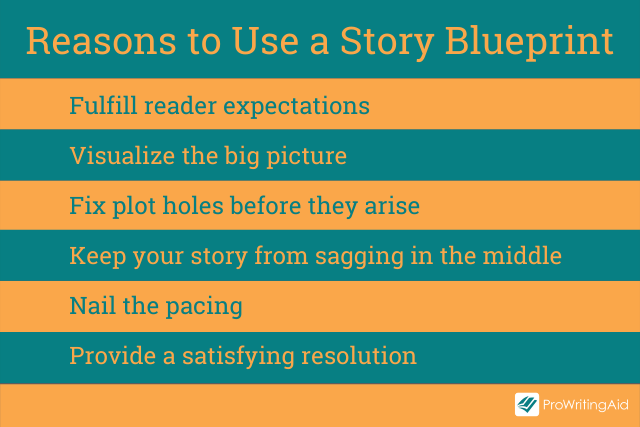
This article will give you a complete blueprint for writing a romance novel that will make readers keep turning the pages.
What Is Three-Act Story Structure?
There are many story structures you can use to create a plot outline, from Blake Snyder’s “Save the Cat” beat sheets to Joseph Campbell’s Hero’s Journey.
In this article, we’ll be using one of the most popular outline templates: the three-act story structure.
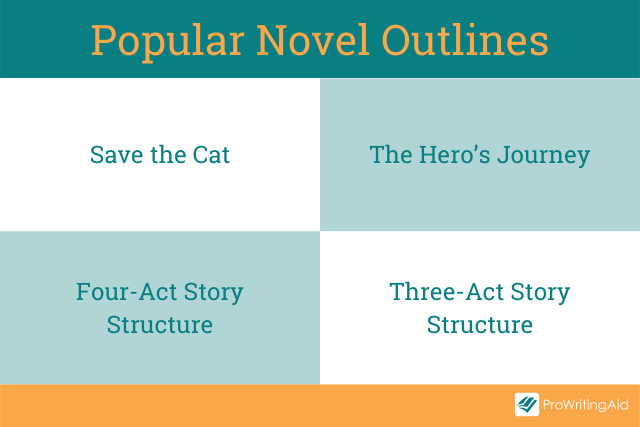
The three-act story structure is one of my favorites. It’s simple enough to work for almost any novel-length story, but still detailed enough to give you specific scenes to work with.
If you’re new to the concept, check out our article on how to use the three-act story structure for a novel of any genre.
Essentially, the three-act story structure involves splitting your romance novel into a beginning, middle, and end. Each of these sections include core plot points to keep up the tension and keep your reader turning the pages.
Here’s an overview of the three acts we’ll be splitting your romance novel into:
- Act One: The Setup (0-25%)
- Act Two: The Confrontation (25-75%)
- Act Three: The Resolution (75-100%)
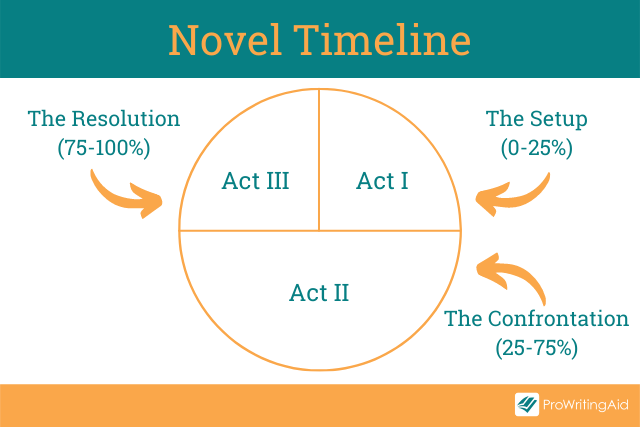
So how do you take this plot outline and apply it specifically to the romance genre? Read on for a detailed blueprint for building an irresistible romance novel.
What Should I Include in Act One Of a Romance Novel?
We start with Act One—the setup stage of the story.
This act encompasses the first quarter of your novel. Your focus in Act One should be to lay all the groundwork you’ll need for the rest of the novel.
You need to introduce readers to your cast of characters, establish the setting, and set up the promise of what the narrative arc will be.
As early as possible, introduce the two main characters and make them feel like real people outside of their romantic lives.
Give the two characters external goals that have nothing to do with the relationship itself—such as starting a business, succeeding in a new job, or winning a competition.
Show that each character has fears and flaws that might make it hard for a long-term relationship to work out unless they’re willing to grow as a person.
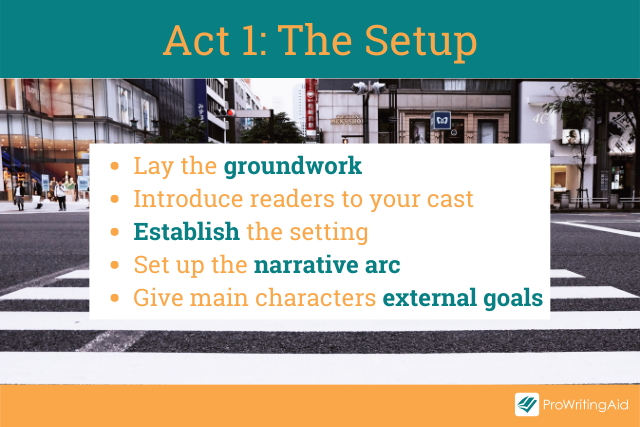
Choose a Unique Meet-Cute
Around 1-12% of the way into the novel, we get to the first story beat in your plot outline: the inciting incident, which sets off the entire chain of events that follows.
In a romance novel, this is the meet-cute—the moment your two main characters meet.
A meet-cute is a necessity for any romance novel. You should establish the possibility for attraction without making it instantaneous. Leave the reader wanting more.
There are countless meet-cutes out there, and it’s a lot of fun to come up with your own. It could be as mundane as having your two characters sit next to each other on the bus, or it could be as dramatic as having one rescue the other from mortal peril.
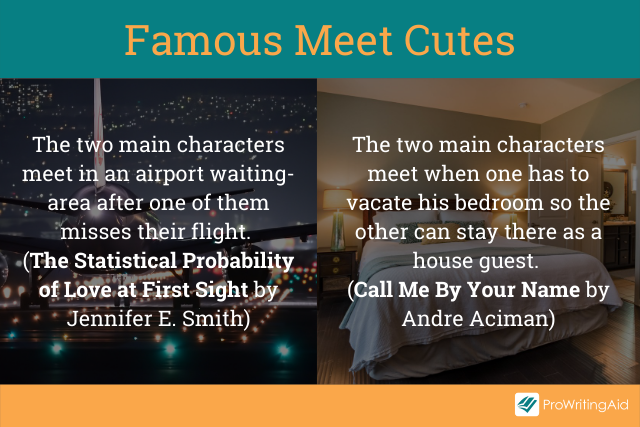
If your characters already know each other—for example, if they’re childhood best friends, or if they’re ex-lovers yearning for a second chance—this scene should be the first time we see them together on the page. If they don't know each other yet, this should be the first time they meet.
Keep the Protagonist Thinking About the Love Interest
No matter what the meet-cute is, there must be some challenge that stops the two love interests from getting together right away. Love can’t come easy in a romance novel. To keep readers turning the page, you need to build tension and suspense.
After the inciting incident, the protagonist should agonize over whether or not they actually want to take the next step forward. It’s important to set the stage for the conflict that will get in their way.
The protagonist might deny that they’re attracted to their love interest to protect themselves from the possibility of rejection. Or they might assume they can’t be together because of some kind of external conflict.
It is important to get the pacing right at this crucial point in your novel. Too quick and readers will not have developed a strong enough emotional attachment to your protagonist.
Too slow and they may become bored and—gasp—stop reading. To avoid disasters, try out ProWritingAid's Pacing Report, which highlights slow paragraphs and suggests that you do not have too many in a row.

In spite of this conflict, however, the protagonist can’t stop thinking about the love interest and wondering if there might be a way to make it work. This brings us to the first plot point.
Force the Protagonist to Make a Choice
After all this internal debate, your protagonist will accept the call of the meet-cute and agree to take the next step forward. This plot point should happen around a quarter of the way into the novel.
Whatever this next step is, it means the protagonist and their love interest will be seeing a lot more of each other.
This is a good time to consider which tropes you want to use in your story, since many tropes come with a built-in first plot point. If you're looking for romance-plot ideas, these tropes can definitely help spark your imagination.
Here are some examples of tropes that all romance writers should know:
- The fake-dating trope: the protagonist decides to pretend they’re in a relationship with the love interest
- The rivals-to-lovers trope: the protagonist agrees to enter a competition in which the love interest is a rival contestant
- The friends-to-lovers trope: the protagonist decides to accept a job, new house, or other external circumstance that will bring them into close proximity to the love interest
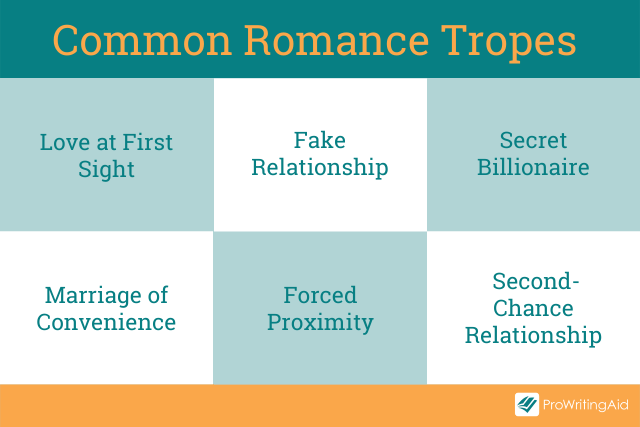
While the inciting incident could be something that happens out of the blue, the first plot point should usually be an active choice for the protagonist, even if they still have their reservations.
Until now, they could always walk away. But after this, there will be no turning back.
This decision will push the story into Act Two.
What Should I Include in Act Two Of a Romance Novel?
Act Two is the meat of the story, where you bring the two love interests together and enjoy the drama that ensues.
This act is where you build momentum for the relationship. Now that your two love interests are stuck in the same place and forced to get to know each other better, the romantic tension should begin to pick up.
You want to deepen the attraction and the conflict at the same time, hand-in-hand. They key is to make the reader think “Will they be able to end up together?” without us giving a definitive answer until Act Three.
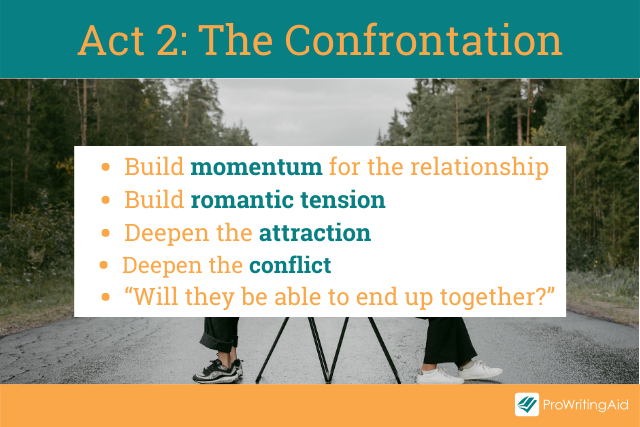
Build the Romantic Tension
This section of the story is your chance to fulfill the expectations that made readers pick up your book in the first place. Different sub-genres will have different expectations they need to fulfill. These can help you understand what your readers expect.
- In a Western romance novel, readers will want to see rodeo shows, ranching events, and/or other traditionally Western activities
- In a Regency romance novel, readers will want to see ballroom dances, gossip and scandal, and/or strict social rules
- In a paranormal romance novel, readers will want to see a hidden magical academy, a dystopian society, and/or paranormal creatures
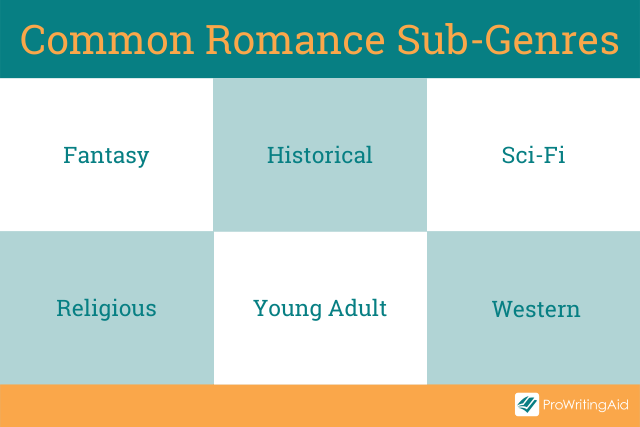
Fulfilling these reader expectations has the added benefit of giving you more romance plot ideas. With all of these sub-genre conventions as the backdrop, the action should steadily rise until you get to the midpoint.
As the two characters get to know each other more, they learn to trust each other and to like each other in a deeper way. The romantic attraction should simmer and build.
Give them ample opportunity to spend time together. Perhaps they share secrets about themselves or begin to reveal vulnerabilities. One way or another, they begin to see each other in a new light.
In spite of the attraction growing between them, at least one of the two characters needs to be hesitant to jump into the relationship. All romance novels need conflict. Otherwise, you get to your happy ending too early.
As the two characters get to know each other better, they also deepen the fundamental conflict that might make it impossible for them to be together.
Here are some examples of external conflicts you can use:
- Friends or family who disapprove
- Ex-lovers who try to interfere
- A job or other external obligation that physically keeps them apart
And here are some examples of internal conflicts you can use:
- Secrets and misunderstandings between the two characters
- Past baggage that prevents the two characters from fully trusting each other
- An inability to commit to a real relationship

Shake Things Up at the Midpoint
In the middle of your story, you get to the midpoint reversal.
This scene is a new turn of events that feels like either a false victory or a false defeat.
If it’s a false victory, you want the reader to think that the two main characters are close to their “happily ever after.”
A false victory might be the point when the two characters finally declare their affection for each other. They might share their first kiss, or even their first night together, depending on the spice level of your novel.
If it’s a false defeat, on the other hand, you want the reader to think that the two characters can’t be together after all. Some crisis arises that makes them deny their feelings or wonder if this was all a mistake.

Either way, it’s false, because the story isn’t over yet. If it’s a false victory, make sure to bring the conflict back into the budding relationship as soon as the midpoint is over. If it’s a false defeat, give us hope again.
After this, the two characters will be forced to be make decisions about what they really want. If they truly want to be together, they’ll need to find their way back to a middle ground.
It’s time to turn up the pressure and force the main characters to confront the problems they’re facing, both internal and external.
Don’t fully resolve the conflict yet. Save your trump card for the end.
Teach the Protagonist a Lesson
The process of the two characters finding their way back to each other should continue until the 75% mark, when you get to the second plot point.
The second plot point is when your protagonist looks deep inside themselves and realizes that their own flaw has been holding them back. If they want love, they need to confront their own flaw or misbelief first.
This should tie back to the inner conflict you've established throughout the story so far.
Even if you're using an external conflict, you should make sure it relates to the character's internal growth—for example, by being willing to stand up to their disapproving family.
Character growth is a huge part of what makes a novel captivating. If you nail this story beat, you’ll be able to tug at readers’ heartstrings while also imparting a nugget of wisdom.
Here are some examples of lessons learned:
- The protagonist was too afraid of commitment to let the relationship evolve, and now they realize they need to stop making decisions out of fear
- The protagonist always believed they needed to choose between falling in love and succeeding in their career, and now they realize they need to put in the work to have both at once
- The protagonist was pining after the wrong person because they thought they needed love to make them complete, and now they realize they need to put themselves first
Once the main characters learn this crucial lesson, they can finally move forward into the third act.
What Should I Include in Act Three Of a Romance Novel?
In the final act of the story, the two main characters will come back stronger—this time, armed with the new lessons they’ve learned along the way.
If your novel has a Happily Ever After (HEA), this act will end with the two protagonists falling in love.
If not, it will end with the two protagonist parting ways, having learned something new about themselves in the process.
Let The Protagonist Fall in Love
Between 75-90% of your romance novel, the two characters will finally admit they’re falling in love with each other. They’ve learned their lessons, faced their own flaws, and decided they want to be together.
This section is a good time for the romantic and even physical intimacy to escalate. It’s finally time to dial up the spice.

Make the reader feel almost certain that it will all work out—but then, almost at the last minute, take us to the climax and bring the conflict back with a vengeance.
Give Us a Climactic Breakup
In the climax, the conflict that’s been getting in the two main characters’ way should finally come to a head.
This scene is when you play your trump card—the terrible obstacle between them that we all knew was coming but tried to ignore anyway.
The reader should question whether the two main characters even have a future together. The climax usually involves a breakup, a moment when the reader truly thinks it’s over. Everything should appear hopeless.
To figure out what your climax should be, examine the faults and flaws of each character. What would get in the way of their happy ending if they aren’t willing to grow and change?
Here are some examples you could use:
- A disapproving parent steps in and tells the protagonist they will never approve of this relationship
- An ex-lover declares their undying love and makes the protagonist question if they’re with the right person at all
- The love interest discovers that the protagonist’s been keeping a big secret from them and feels blindsided and betrayed
Make sure the crisis is believable and grounded in what you’ve established throughout the entire novel so far. This shouldn’t be a bolt of lightning out of a clear sky—it should come out of flaws that we already knew would get in the way.
Put in the Work to Rebuild Their Relationship
The climax also shouldn’t be an easy solve. Whatever the problem is, it should be severe enough that it will take multiple chapters for the two main characters to overcome the issue to rebuild the relationship.
In the chapters following the climax, one or both of the two characters must make a choice. They must decide to sacrifice something in order to be together.
Here are some examples:
- If the climax was caused by the disapproving parent, the protagonist may need to stand up to their parents and sacrifice their family’s approval
- If the climax was caused by the ex-lover, the protagonist may need to turn down the offer and sacrifice the love they used to crave in the past
- If the climax was caused by the big secret, the protagonist may need to show more vulnerability and sacrifice their emotional shields and barriers
Whatever this choice is, it should prove that the main characters have grown throughout the story and are ready to make a true commitment to one another.
Afterwards, the relationship will come out even stronger for it.
Give Us a Taste of Their Happily Ever After
Now that the final conflict has been solved, it’s time to wrap up your plot outline.
If you’re writing a romance with a happy ending, this will usually involve a declaration of love.
Keep the denouement short and sweet—don’t draw it out so much that you lose the romantic tension you’ve worked so hard to build.
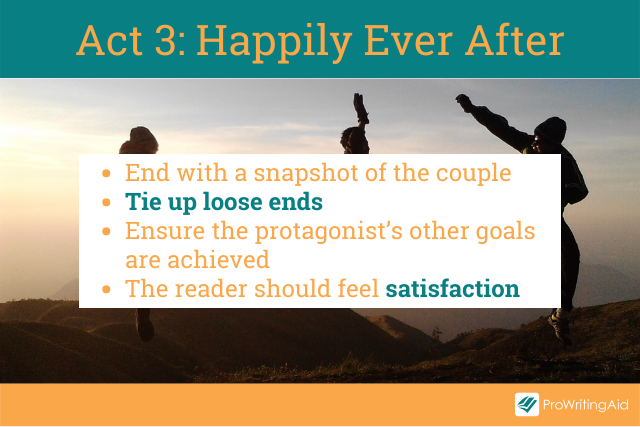
You can end with a snapshot of the couple together—perhaps as an epilogue, a year or two down the line. Tie up loose ends and give the reader a hint at how the couple could make a long-term relationship work.
If you’re writing a romance novel with a tearjerker ending, you should make sure some of the protagonist’s other goals are achieved instead. The reader should still feel some amount of satisfaction, even through their tears.
Final Words About Writing a Romance-Novel Outline
If you can hit all these plot points, congratulations—you'll have a fantastic plot outline for your romance story.
What are your favorite romance novels? Do they fit into this three-act story structure? Let us know in the comments.
About the Author
Speculative Fiction Author




No comments:
Post a Comment